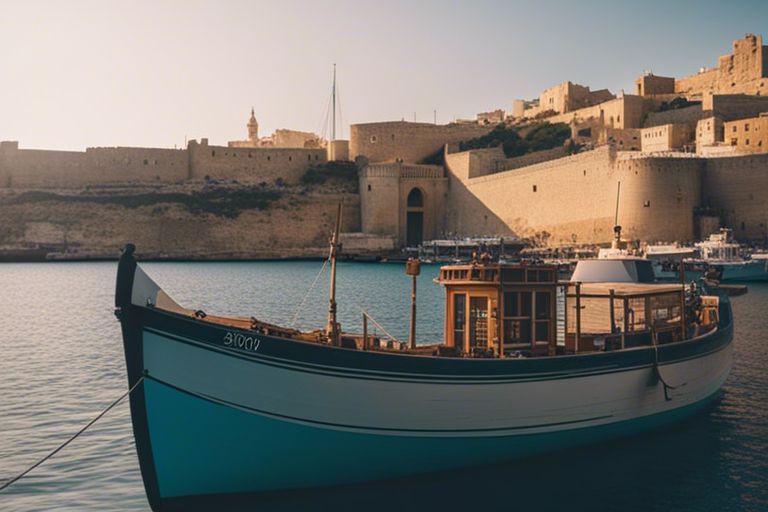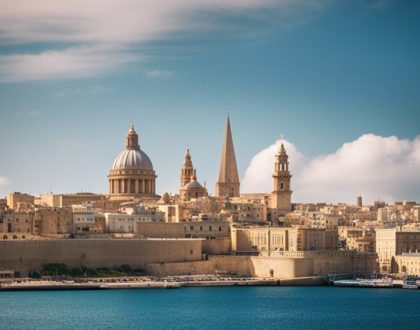Exploring Malta’s Maritime Heritage

Exploration of Malta’s maritime heritage offers a deep examine the island’s rich nautical history, filled with captivating stories of ancient seafaring, naval battles, and centuries-old traditions. Malta, strategically located in the heart of the Mediterranean, has been a crossroads of civilizations for thousands of years, leaving behind a tapestry of maritime wonders waiting to be discovered.
This nautical guide will take you on a journey through Malta’s historic harbors, towering fortifications, and crystal-clear waters teeming with marine life. From exploring ancient shipwrecks to witnessing traditional boat races, Malta’s maritime heritage offers a unique blend of adventure, history, and cultural immersion for nautical enthusiasts of all kinds.
Gain a deeper understanding of Malta’s seafaring past as you navigate through its iconic lighthouses, bustling ports, and quaint fishing villages. Whether you’re a history buff, a nature lover, or an avid sailor, this nautical guide will provide you with the tools and insights needed to explore Malta’s maritime heritage in all its glory, ensuring an unforgettable journey through the island’s nautical wonders.
Types of Maritime Heritage in Malta
To truly understand Malta’s rich maritime heritage, one must explore the various types of nautical remnants that dot the islands. The maritime heritage of Malta encompasses a wide range of historical sites and artifacts that showcase the region’s seafaring past. From ancient shipwrecks to marine fortifications, Malta offers a treasure trove of maritime history waiting to be discovered.
- Ancient Shipwrecks
- Historic Harbours and Docks
- Marine Fortifications
- Underwater Archaeological Sites
Ancient Shipwrecks
Little is known about ancient shipwrecks off the coast of Malta, but these underwater archaeological sites offer a glimpse into the past. The ancient shipwrecks lying on the seabed around the islands date back centuries and provide valuable insights into maritime trade routes and shipbuilding techniques of the time.
Exploring these shipwrecks not only uncovers historical artifacts but also sheds light on the challenges and dangers faced by sailors navigating the Mediterranean waters. These ancient shipwrecks are an important part of Malta’s maritime heritage and are protected to preserve their historical significance.
After centuries beneath the waves, these ancient shipwrecks continue to captivate and intrigue archaeologists and history enthusiasts alike, offering a window into Malta’s seafaring past.
Historic Harbours and Docks
Roman artifacts and remnants of ancient docks and harbours provide a glimpse into the bustling maritime activity that once thrived in Malta. These historic harbours and docks served as vital hubs for trade and transportation in the region, connecting Malta to various Mediterranean civilizations.
This maritime infrastructure not only facilitated the movement of goods and people but also played a crucial role in the defense of the islands against maritime threats. The historic harbours and docks in Malta stand as a testament to the island’s strategic importance in the ancient maritime world.
This network of historic harbours and docks played a vital role in shaping Malta’s maritime heritage and continues to be a focal point for historical exploration and preservation efforts.
Marine Fortifications
Harbours in Malta are adorned with marine fortifications that once served as defensive bastions against invaders. These fortifications, including watchtowers, coastal defenses, and fortresses, are a prominent feature of Malta’s coastal landscape, reflecting the island’s turbulent history.
Prehistoric coastal fortifications, such as the megalithic temples of Ħaġar Qim and Mnajdra, offer a glimpse into the ancient maritime culture of Malta. These marine fortifications are not only architectural marvels but also stand as symbols of resilience and ingenuity in the face of maritime threats.
Exploring these marine fortifications provides a deeper understanding of Malta’s maritime heritage and the strategic significance of these coastal defenses throughout history.
Underwater Archaeological Sites
Malta boasts an array of underwater archaeological sites that offer a unique perspective on the island’s maritime history. From submerged temples and ancient anchors to sunken artifacts, these underwater sites hold invaluable clues to Malta’s seafaring past.
Traders and seafarers frequented these underwater routes, leaving behind a trail of archaeological treasures that continue to be discovered and studied by experts. These underwater archaeological sites not only contribute to our understanding of Malta’s maritime heritage but also showcase the advanced maritime technology of the past.
Exploring these underwater archaeological sites requires specialized diving skills and permits, but the rewards are immense for those who seek to unravel the mysteries of Malta’s underwater past.
Planning Your Maritime Exploration
Research and Documentation
Even before commenceing on your maritime exploration in Malta, it is crucial to conduct thorough research and gather the necessary documentation. This includes studying the maritime history of Malta, identifying must-visit maritime sites, and understanding the current marine regulations in the region. By immersing yourself in this knowledge, you can truly appreciate the significance of Malta’s maritime heritage and navigate its waters with respect and understanding.
For a more enriching experience, consider visiting maritime museums and speaking with local experts to gain insights into the maritime traditions and practices of the Maltese people. Additionally, make sure to have all relevant permits and licenses required for your marine activities to ensure a smooth and compliant exploration.
Exploring Malta’s maritime heritage will be immensely rewarding when armed with the right research and documentation. This preparation will not only enhance your understanding of the nautical wonders of Malta but also contribute to the preservation of its rich maritime history for future generations.
Selecting the Right Season
With Malta’s mild Mediterranean climate, choosing the right season for your maritime exploration is imperative for a comfortable and enjoyable experience. The summer months from June to August offer warm weather and clear skies, ideal for water activities such as snorkeling, diving, and boating. However, these months can also be crowded with tourists.
Plus, the shoulder seasons of spring and fall provide pleasant temperatures and fewer crowds, making them excellent times to explore Malta’s maritime sites in tranquility. Keep in mind that winter in Malta, from November to February, can be cooler and rainy, but it offers a unique perspective on the island’s maritime heritage and a chance to experience local life away from the peak tourist season.
Equipment Checklist for Marine Excursions
Before setting out on your maritime exploration in Malta, it is imperative to pack the right equipment to ensure your safety and enjoyment. Depending on your planned activities, consider bringing items such as snorkeling gear, sunscreen, a first aid kit, navigational tools, and appropriate clothing. It is also advisable to have a reliable communication device, such as a waterproof phone or a VHF radio, in case of emergencies.
Contextualize your equipment checklist based on the specific maritime sites and activities you intend to explore in Malta. For instance, if you plan to visit underwater caves or shipwrecks, make sure you have the necessary diving equipment and certifications. Additionally, familiarize yourself with local regulations to ensure you are compliant with safety standards during your marine excursions.
Maritime explorations in Malta can be a thrilling experience, but proper planning and preparation are key to a successful and safe journey. By packing the right equipment, understanding the seasonal dynamics, and conducting thorough research, you can make the most of your nautical adventure while honoring Malta’s illustrious maritime heritage.
A Step-by-Step Guide to Visiting Maritime Museums
Keep Exploring Malta’s Maritime Heritage by begining on a journey through the island’s rich nautical history. Visiting maritime museums is a fantastic way to investigate into the seafaring past of Malta, an archipelago with a long-standing maritime tradition. To make the most of your visit, follow this step-by-step guide that will ensure you have an enriching and memorable experience.
| National Maritime Museum Highlights | Conducting Effective Museum Visits |
National Maritime Museum Highlights
Now, let’s investigate into the National Maritime Museum Highlights. The National Maritime Museum in Birgu is a treasure trove of artifacts and exhibitions that showcase Malta’s maritime prowess. From ancient seafaring tools to models of historic ships, the museum offers a comprehensive look at Malta’s maritime history. Make sure not to miss the impressive collection of naval weaponry and intricate navigational instruments that have guided sailors through the Mediterranean for centuries. There’s a wealth of knowledge to absorb at the National Maritime Museum, so approach your visit with a sense of curiosity and wonder. Take your time exploring each exhibit, reading the accompanying descriptions, and absorbing the details that bring Malta’s maritime past to life. Engage with museum staff to gain further insights into the exhibits and ask questions to deepen your understanding of the artifacts on display. Don’t rush through the museum; instead, savor each moment as you immerse yourself in Malta’s maritime heritage. This immersive experience at the National Maritime Museum will leave you with a newfound appreciation for Malta’s seafaring legacy. Take the time to reflect on the historical significance of each artifact and how it has shaped Malta’s identity as a maritime nation. The museum provides a unique opportunity to connect with the past and gain a deeper understanding of the challenges and triumphs that defined Malta’s maritime history. Allow yourself to be transported back in time as you wander through the museum’s halls, tracing the footsteps of sailors who once navigated the waters surrounding the Maltese islands.
Tips for Engaging with Local Nautical Traditions
Your journey into Malta’s maritime heritage is not complete without immersing yourself in the local nautical traditions. Here are some tips to help you engage with these rich cultural practices:
- Respect Local Customs: When interacting with the local community, it is necessary to show respect for their nautical traditions. This includes following any customs or etiquette that may be in place.
- Participate in Festivals: Malta is known for its vibrant maritime festivals, where you can witness traditional boat races, music, and food. These events offer a unique opportunity to experience the seafaring culture firsthand.
- Visit Boatyards: Exploring traditional boatyards will give you a glimpse into the craftsmanship involved in building and maintaining traditional Maltese boats, such as the iconic luzzu.
Assume that by embracing these tips, you will gain a deeper appreciation for Malta’s maritime heritage and forge meaningful connections with the local community.
Participating in Maritime Festivals
You can fully immerse yourself in Malta’s maritime culture by participating in the various maritime festivals held throughout the year. These events showcase the island’s seafaring traditions through lively celebrations that include boat races, fishermen’s processions, and traditional music and dances. By joining in the festivities, you will not only witness the pride and passion that the Maltese people have for their nautical heritage but also create lasting memories of your visit.
Visitors often find themselves captivated by the vibrant colors of the traditional fishing boats, the skillful maneuvers of the sailors, and the tantalizing aroma of fresh seafood being cooked along the harbors. These festivals provide a unique opportunity to experience Malta’s maritime traditions in a dynamic and engaging way, offering a glimpse into the island’s rich seafaring history.
Experiencing Traditional Boat Building
Engaging with Malta’s maritime heritage also involves exploring the traditional craft of boat building. In Malta, skilled artisans continue to handcraft traditional boats using age-old techniques passed down through generations. These boats, such as the luzzu with its distinctive eye motif, are an integral part of the island’s maritime identity.
The process of traditional boat building is not just a skill but a form of artistry that requires precision, patience, and a deep understanding of the sea. By visiting boatyards and witnessing craftsmen at work, you can gain a profound appreciation for the craftsmanship and dedication that goes into each vessel. The legacy of boat building in Malta serves as a testament to the enduring connection between the island’s people and the sea.
Factors Influencing the Preservation of Maritime Heritage
Many factors come into play when considering the preservation of maritime heritage. It is important to understand the impact of environmental factors, socio-economic considerations, legislation, and public awareness on the protection and maintenance of maritime sites. These factors collectively influence the decision-making processes that determine the fate of shipwrecks, harbors, and other maritime artifacts that form part of our cultural legacy.
Environmental Impact on Maritime Sites
Now, the environmental impact on maritime sites is a significant concern. Natural processes such as erosion, corrosion, and sedimentation can accelerate the degradation of underwater cultural heritage. Increased sea levels due to climate change pose a threat to submerged sites that have been well preserved for centuries. It is crucial to monitor and mitigate these environmental factors to ensure the long-term survival of maritime heritage.
Socio-Economic Considerations
If we investigate into socio-economic considerations, we find that commercial activities such as industrial development, tourism, and urbanization can exert pressure on maritime sites. Development projects near coastal areas may inadvertently impactunderwater cultural heritage through pollution and habitat destruction. Community involvement and stakeholder engagement are crucial in balancing economic interests with the preservation of our maritime legacy. With archaeologists, conservationists, and divers working tirelessly to expand our knowledge of maritime heritage, it is imperative to recognize the complex interplay of factors that influence the preservation of maritime sites. By educating the public, enforcing protective legislation, and promoting sustainable practices, we can secure a lasting legacy for future generations to appreciate and enjoy. Perceiving maritime heritage as a valuable resource that enriches our cultural identity is the first step towards ensuring its preservation.
Pros and Cons of Diving in Malta
| Pros | Cons |
| Crystal clear waters | Busy dive sites |
| Rich marine life | Challenging underwater currents |
| Historical wrecks to explore | Visibility can be reduced at times |
| Varied dive sites for all experience levels | Limited diving infrastructure |
| Excellent dive training facilities | Weather dependency for diving |
The Divers' Paradise: A Review of Malta's Dive Sites
Little can compare to the underwater wonderland that awaits divers in Malta. The island boasts a myriad of dive sites, from shallow reefs teeming with colorful fish to deep caverns and impressive wrecks that attract advanced divers. The clarity of the water in Malta is renowned, offering visibility that can reach up to 30 meters on a good day. Divers can explore fascinating sites such as the Blue Hole in Gozo, the Um El Faroud wreck, and the famous Azure Window arch.
Malta’s diverse underwater topography caters to all levels of diving expertise, making it an ideal destination for beginners and seasoned divers alike. The abundance of marine life is staggering, with octopus, moray eels, and groupers commonly spotted during dives. The warm Mediterranean waters provide a comfortable environment for underwater exploration, ensuring a memorable diving experience for all who visit.
Exploring Malta’s dive sites is a true adventure, offering the chance to uncover centuries-old shipwrecks, mysterious caves, and vibrant coral reefs. The underwater landscapes are as varied as they are enchanting, promising an unforgettable journey into the depths of Malta’s maritime history and natural beauty.
Challenges in Maltese Waters
Diving in Malta is not without its challenges. The underwater currents around the islands can be strong and unpredictable, requiring divers to possess a certain level of experience and skill to navigate safely. Additionally, the busy nature of some dive sites can lead to overcrowding, impacting the overall diving experience. Weather conditions can also play a significant role in dive plans, as winds and visibility can change rapidly in the Mediterranean.
For instance, the currents around the islands can create hazardous conditions for divers, potentially leading to drift diving situations. It is vital for divers to stay vigilant and be prepared for sudden changes in underwater conditions. Despite these challenges, diving in Malta offers unparalleled opportunities to explore historical wrecks, encounter marine life up close, and immerse oneself in the rich maritime heritage of the Mediterranean.
Maintenance and Restoration Efforts in Maritime Conservation
Once again, Malta’s commitment to preserving its rich maritime heritage is evident in the various maintenance and restoration efforts undertaken to conserve its historic boats, shipwrecks, and coastal structures. These conservation activities play a vital role in ensuring that future generations can continue to appreciate and learn from Malta’s nautical history.
Case Studies of Successful Restoration
Studies have shown that successful restoration projects have been carried out on several significant maritime artifacts in Malta. These projects have not only preserved the historical integrity of these objects but have also enhanced their structural stability and longevity. Some noteworthy case studies include:
- Restoration of the Luzzu: The iconic Maltese fishing boat, the luzzu, was meticulously restored using traditional boat-building techniques, preserving its cultural significance.
- Conservation of the HMS Maori wreck: The sunken World War II shipwreck underwent extensive conservation efforts to prevent further deterioration and protect it for future generations.
- Rehabilitation of coastal watchtowers: Several coastal watchtowers dating back to the Knights of St. John period were restored to their former glory, serving as important historical landmarks along Malta’s coastline.
Participating in Conservation Activities
Conservation enthusiasts and volunteers have the opportunity to participate in various activities aimed at preserving Malta’s maritime heritage. These activities may include hands-on restoration work, educational programs on marine conservation, and guided tours of historical sites. By actively engaging in these conservation efforts, individuals can contribute to safeguarding Malta’s nautical legacy for years to come.
Areas of focus for conservation activities in Malta include underwater archaeology, coastal erosion prevention, and maintenance of historic boats and structures. Volunteers play a crucial role in these efforts, assisting professional conservators and archaeologists in their work. By raising awareness and involving the community in conservation projects, Malta continues to lead the way in maritime heritage preservation.
Navigating Maritime Law and Ethics
Understanding International Maritime Law
Unlike land-based laws, maritime law is a complex framework of rules and regulations that govern activities on the open seas. Understanding the intricacies of international maritime law is crucial for anyone involved in maritime activities, from ship captains to shipping companies. International conventions such as the United Nations Convention on the Law of the Sea (UNCLOS) provide the legal framework for issues such as territorial waters, navigation rights, and environmental protection.
Understanding the nuances of international maritime law can help prevent disputes between nations and ensure the safety and security of vessels at sea. It also plays a vital role in promoting sustainable maritime development and protecting the marine environment. Compliance with international maritime law is not only a legal obligation but also a moral imperative to maintain order and cooperation on the world’s oceans.
For countries like Malta, whose economy and culture are deeply intertwined with maritime activities, adherence to international maritime law is vital. By upholding these legal standards, Malta can continue to be a responsible maritime player on the global stage and contribute to the protection of the world’s oceans for future generations.
Ethical Considerations and Best Practices
Maritime professionals and enthusiasts must be mindful of the ethical considerations and best practices that govern their actions on the seas. includes respecting the rights of other vessels, following established navigation rules, and prioritizing the safety of crew members and passengers. Furthermore, protecting marine biodiversity and ecosystems should be a top priority for anyone engaging in maritime activities.
This ensures the sustainability of our oceans and the resources they provide. While there are legal frameworks in place to regulate maritime activities, ethical considerations go beyond compliance with laws. It encompasses a sense of responsibility and stewardship towards the marine environment, promoting a culture of respect and sustainability in all maritime endeavors. By embracing ethical principles and best practices, we can help preserve Malta’s maritime heritage and ensure that our oceans remain healthy and thriving for years to come.
Advancements in Maritime Archaeology
Technological Innovations in Underwater Research
After years of relying on traditional diving methods for underwater archaeological excavations, the field of maritime archaeology has seen a significant boost thanks to technological innovations. Modern techniques such as remote sensing, photogrammetry, and 3D modeling have revolutionized the way underwater sites are explored and documented. These advancements have enabled researchers to uncover shipwrecks and artifacts with much greater precision and efficiency.
Maritime archaeologists now use cutting-edge equipment like underwater drones and autonomous underwater vehicles (AUVs) to survey vast areas of the seabed quickly and accurately. These sophisticated tools provide high-resolution images and data without disturbing the fragile underwater environment. The use of sonar technology has also proven to be invaluable in mapping out submerged landscapes and locating archaeological sites hidden beneath the ocean floor.
These technological innovations have not only expedited the process of underwater research but have also greatly enhanced our understanding of maritime heritage. By utilizing the latest tools and techniques, maritime archaeologists can now unravel the mysteries of sunken ships and ancient seafaring cultures with unprecedented detail and clarity.
The Future of Maritime Heritage Exploration
Equipment such as underwater drones, advanced sonar systems, and virtual reality software are paving the way for the future of maritime heritage exploration. The use of Artificial Intelligence (AI) in analyzing data collected from underwater sites is also on the rise, allowing researchers to process vast amounts of information quickly and accurately. These advancements hold great promise for the field, opening up new possibilities for discovering and preserving underwater cultural treasures.
Maritime archaeologists are now able to access and study previously inaccessible underwater sites at greater depths and in more challenging conditions. The use of state-of-the-art equipment has not only made underwater exploration safer and more efficient but has also expanded the scope of maritime heritage research. With ongoing technological developments, the future of maritime archaeology looks brighter than ever, promising thrilling discoveries and a deeper understanding of our nautical past.
Underwater exploration is not without its risks, however, as the extreme environments and delicate nature of underwater archaeological sites require careful handling to avoid damage or loss of valuable historical artifacts.
Summing up
Considering all points discussed in this comprehensive nautical guide, it is evident that Malta’s maritime heritage is rich and diverse, offering a myriad of experiences for history enthusiasts, sailors, and curious explorers alike. From ancient shipwrecks to modern marinas, the islands of Malta and Gozo provide a fascinating insight into the evolution of seafaring in the Mediterranean region.
Exploring Malta’s Maritime Heritage – A Nautical Guide highlights the importance of preserving and celebrating this heritage for future generations. By delving into the history of naval architecture, naval battles, and maritime traditions, visitors can connect with the seafaring past of the Maltese islands and appreciate the significant role that the sea has played in shaping Malta’s identity.
Whether you are a seasoned sailor looking to navigate the waters around Malta or a history buff keen on uncovering the secrets of ancient maritime civilizations, this guide serves as a valuable tool to enhance your understanding and appreciation of Malta’s maritime heritage. With its wealth of information and practical tips, Exploring Malta’s Maritime Heritage is a must-read for anyone with a passion for the sea and a desire to explore the maritime wonders of the Maltese archipelago.
FAQs
What are some key highlights of Malta’s maritime heritage?
Key highlights include exploring ancient shipwrecks, historic harbors and docks, marine fortifications, and underwater archaeological sites, all of which offer a glimpse into Malta’s rich seafaring past.
When is the best time to explore Malta’s maritime sites?
The best time to explore is during the summer months (June to August) for warm weather and clear skies, although spring and fall offer pleasant temperatures and fewer crowds.
What equipment is essential for maritime exploration in Malta?
Essential equipment includes snorkeling or diving gear, sunscreen, a first aid kit, navigational tools, appropriate clothing, and a reliable communication device such as a waterproof phone or VHF radio.
How can one engage with local nautical traditions in Malta?
Engage by respecting local customs, participating in maritime festivals, visiting boatyards to witness traditional boat building, and exploring maritime museums for a deeper understanding of Malta’s seafaring culture.
What are some challenges faced by divers in Maltese waters?
Challenges include strong and unpredictable underwater currents, busy dive sites that can be overcrowded, varying visibility conditions, and weather dependency that can affect diving plans.
Recommended Posts

Financial Planning for Businesses in Malta
July 1, 2024

The Ultimate Malta Shopping Guide
July 1, 2024

Discovering Europe’s iGaming Gems
July 1, 2024



